Quantitative Research Methods in the Social Sciences: An Analysis
VerifiedAdded on 2023/01/03
|6
|1257
|64
Report
AI Summary
This report provides an overview of quantitative research methods as applied within the social sciences. It begins by defining quantitative research and emphasizing its role in understanding societal phenomena through the collection and analysis of numerical data. The main body of the report focuses on two key quantitative research methods: questionnaires and surveys. Each method is explained, and their respective advantages and disadvantages are detailed. Questionnaires are presented as a tool for gathering data from respondents, highlighting their cost-effectiveness and broad reach, while also acknowledging potential drawbacks such as low response rates and interpretation issues. Surveys are described as methods for collecting information from a predetermined group, emphasizing their statistical significance and representativeness, while also pointing out limitations like inflexible designs and potential issues with question appropriateness. The report concludes by summarizing the effectiveness of quantitative research methods and their importance in the social sciences, reiterating the value of surveys and questionnaires in gathering data about beliefs, views, and other societal aspects.
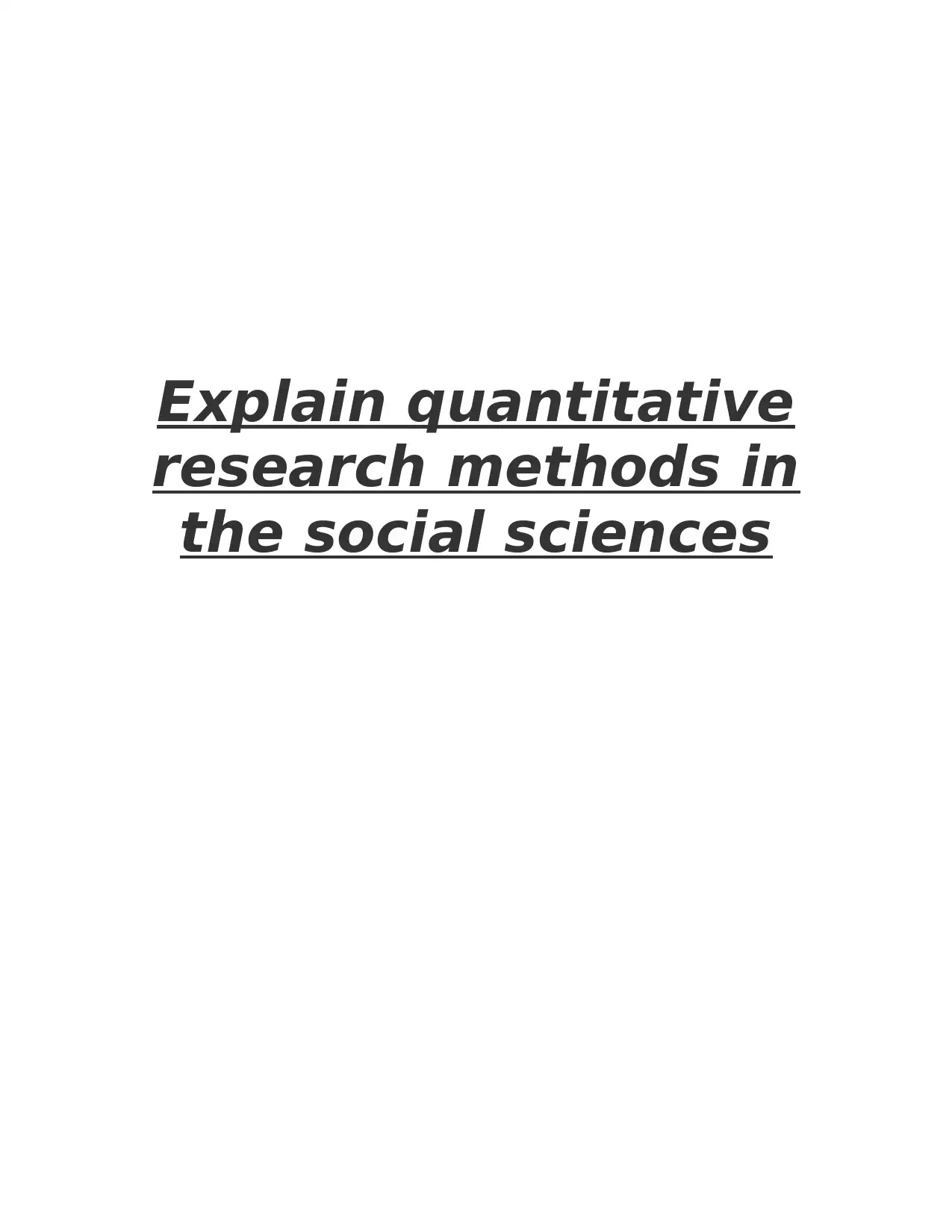
Explain quantitative
research methods in
the social sciences
research methods in
the social sciences
Paraphrase This Document
Need a fresh take? Get an instant paraphrase of this document with our AI Paraphraser
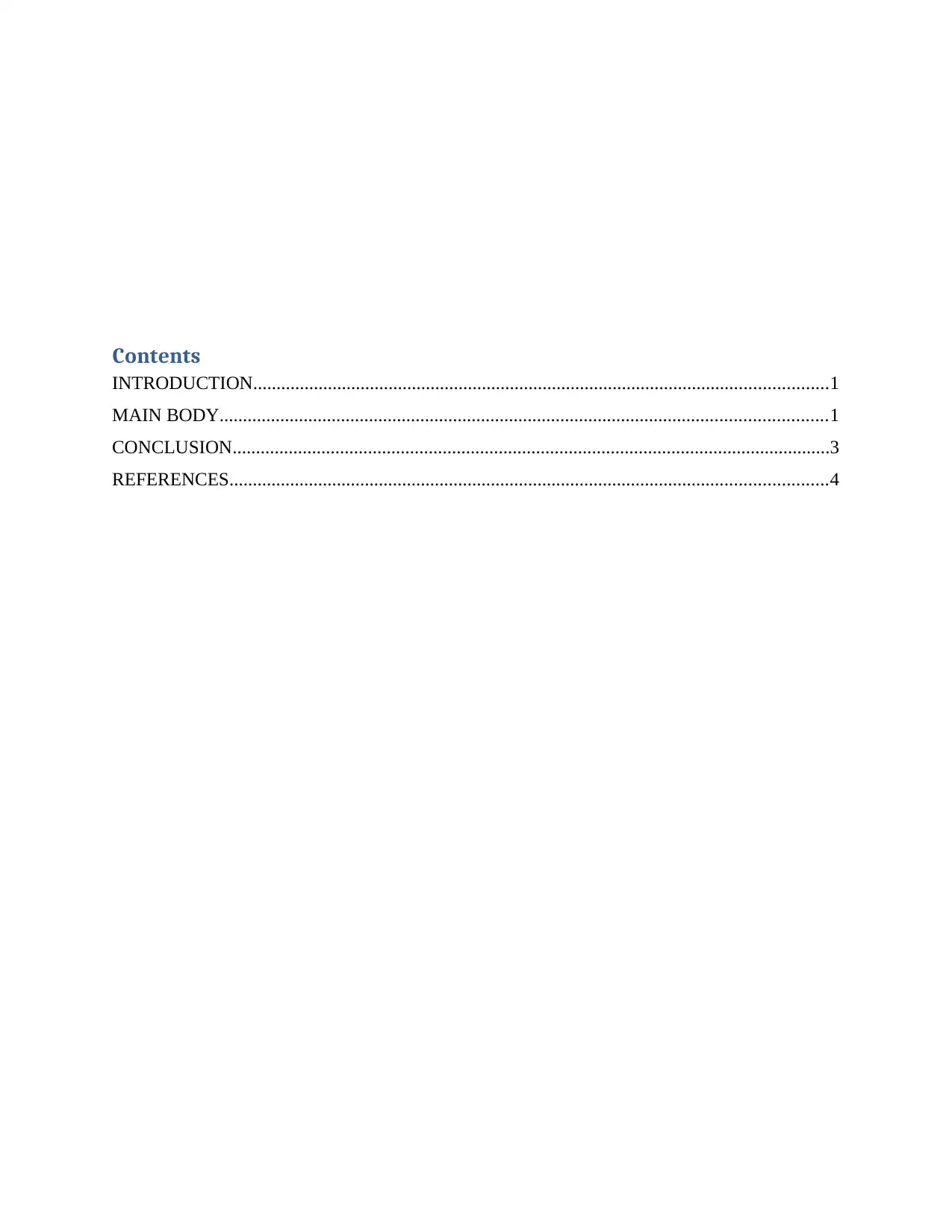
Contents
INTRODUCTION...........................................................................................................................1
MAIN BODY..................................................................................................................................1
CONCLUSION................................................................................................................................3
REFERENCES................................................................................................................................4
INTRODUCTION...........................................................................................................................1
MAIN BODY..................................................................................................................................1
CONCLUSION................................................................................................................................3
REFERENCES................................................................................................................................4
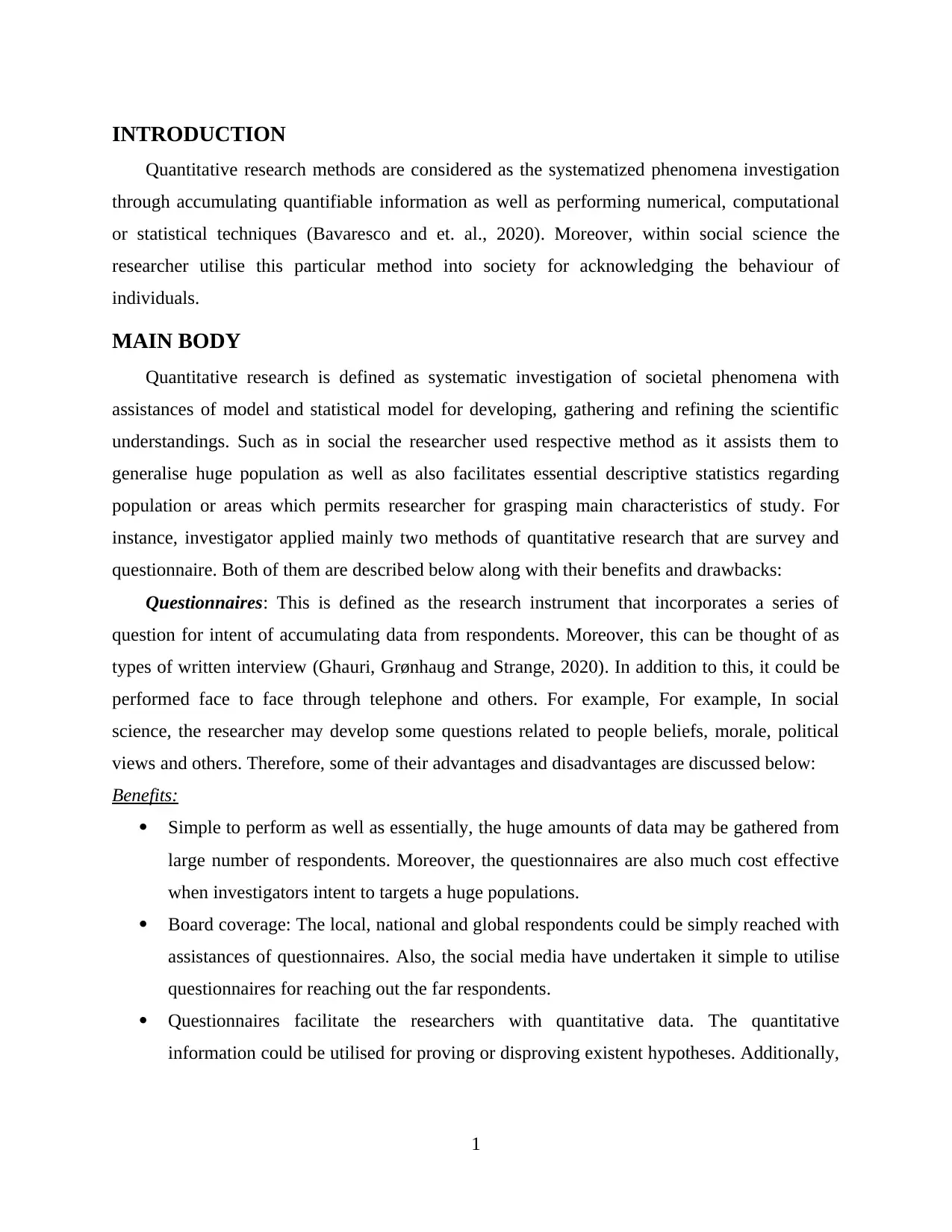
INTRODUCTION
Quantitative research methods are considered as the systematized phenomena investigation
through accumulating quantifiable information as well as performing numerical, computational
or statistical techniques (Bavaresco and et. al., 2020). Moreover, within social science the
researcher utilise this particular method into society for acknowledging the behaviour of
individuals.
MAIN BODY
Quantitative research is defined as systematic investigation of societal phenomena with
assistances of model and statistical model for developing, gathering and refining the scientific
understandings. Such as in social the researcher used respective method as it assists them to
generalise huge population as well as also facilitates essential descriptive statistics regarding
population or areas which permits researcher for grasping main characteristics of study. For
instance, investigator applied mainly two methods of quantitative research that are survey and
questionnaire. Both of them are described below along with their benefits and drawbacks:
Questionnaires: This is defined as the research instrument that incorporates a series of
question for intent of accumulating data from respondents. Moreover, this can be thought of as
types of written interview (Ghauri, Grønhaug and Strange, 2020). In addition to this, it could be
performed face to face through telephone and others. For example, For example, In social
science, the researcher may develop some questions related to people beliefs, morale, political
views and others. Therefore, some of their advantages and disadvantages are discussed below:
Benefits:
Simple to perform as well as essentially, the huge amounts of data may be gathered from
large number of respondents. Moreover, the questionnaires are also much cost effective
when investigators intent to targets a huge populations.
Board coverage: The local, national and global respondents could be simply reached with
assistances of questionnaires. Also, the social media have undertaken it simple to utilise
questionnaires for reaching out the far respondents.
Questionnaires facilitate the researchers with quantitative data. The quantitative
information could be utilised for proving or disproving existent hypotheses. Additionally,
1
Quantitative research methods are considered as the systematized phenomena investigation
through accumulating quantifiable information as well as performing numerical, computational
or statistical techniques (Bavaresco and et. al., 2020). Moreover, within social science the
researcher utilise this particular method into society for acknowledging the behaviour of
individuals.
MAIN BODY
Quantitative research is defined as systematic investigation of societal phenomena with
assistances of model and statistical model for developing, gathering and refining the scientific
understandings. Such as in social the researcher used respective method as it assists them to
generalise huge population as well as also facilitates essential descriptive statistics regarding
population or areas which permits researcher for grasping main characteristics of study. For
instance, investigator applied mainly two methods of quantitative research that are survey and
questionnaire. Both of them are described below along with their benefits and drawbacks:
Questionnaires: This is defined as the research instrument that incorporates a series of
question for intent of accumulating data from respondents. Moreover, this can be thought of as
types of written interview (Ghauri, Grønhaug and Strange, 2020). In addition to this, it could be
performed face to face through telephone and others. For example, For example, In social
science, the researcher may develop some questions related to people beliefs, morale, political
views and others. Therefore, some of their advantages and disadvantages are discussed below:
Benefits:
Simple to perform as well as essentially, the huge amounts of data may be gathered from
large number of respondents. Moreover, the questionnaires are also much cost effective
when investigators intent to targets a huge populations.
Board coverage: The local, national and global respondents could be simply reached with
assistances of questionnaires. Also, the social media have undertaken it simple to utilise
questionnaires for reaching out the far respondents.
Questionnaires facilitate the researchers with quantitative data. The quantitative
information could be utilised for proving or disproving existent hypotheses. Additionally,
1
⊘ This is a preview!⊘
Do you want full access?
Subscribe today to unlock all pages.

Trusted by 1+ million students worldwide
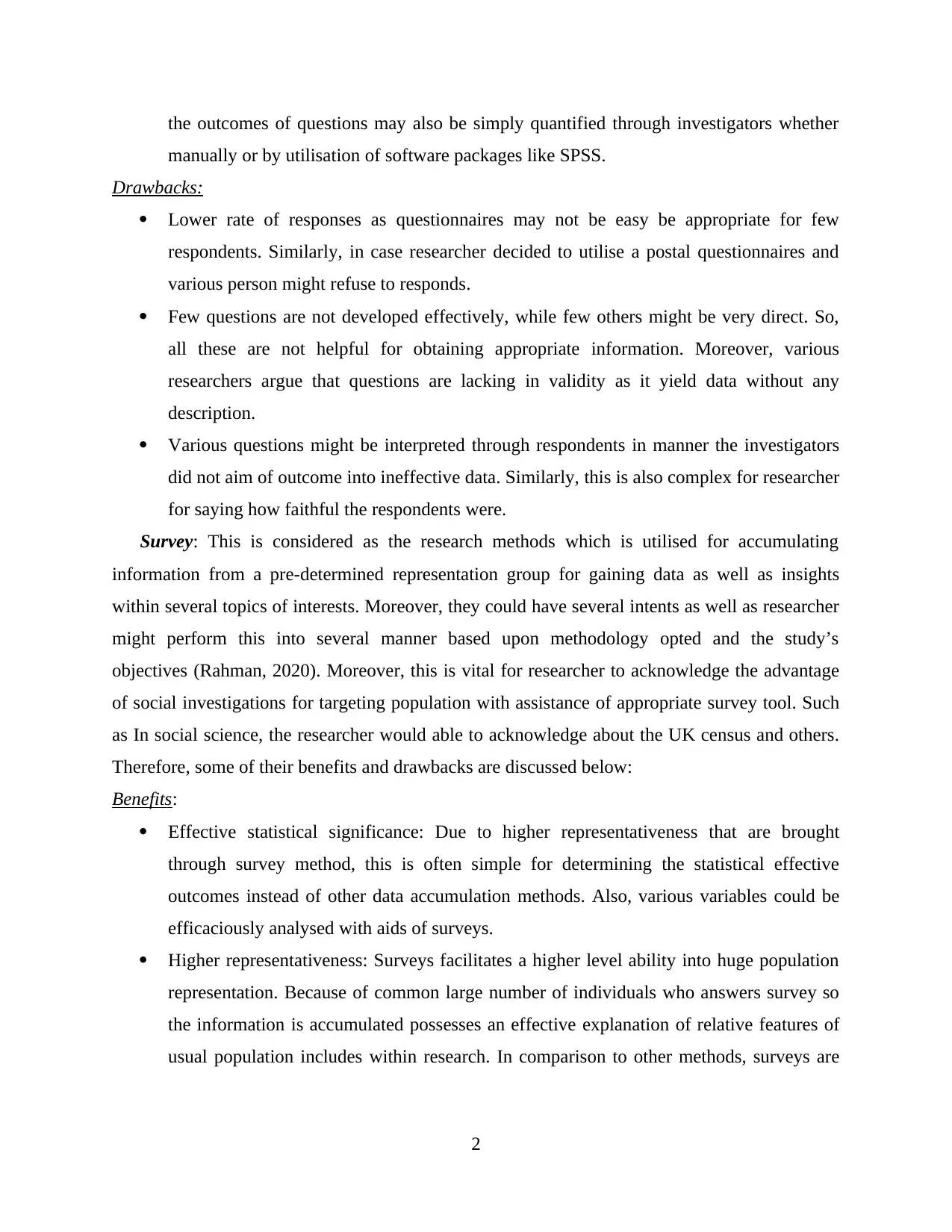
the outcomes of questions may also be simply quantified through investigators whether
manually or by utilisation of software packages like SPSS.
Drawbacks:
Lower rate of responses as questionnaires may not be easy be appropriate for few
respondents. Similarly, in case researcher decided to utilise a postal questionnaires and
various person might refuse to responds.
Few questions are not developed effectively, while few others might be very direct. So,
all these are not helpful for obtaining appropriate information. Moreover, various
researchers argue that questions are lacking in validity as it yield data without any
description.
Various questions might be interpreted through respondents in manner the investigators
did not aim of outcome into ineffective data. Similarly, this is also complex for researcher
for saying how faithful the respondents were.
Survey: This is considered as the research methods which is utilised for accumulating
information from a pre-determined representation group for gaining data as well as insights
within several topics of interests. Moreover, they could have several intents as well as researcher
might perform this into several manner based upon methodology opted and the study’s
objectives (Rahman, 2020). Moreover, this is vital for researcher to acknowledge the advantage
of social investigations for targeting population with assistance of appropriate survey tool. Such
as In social science, the researcher would able to acknowledge about the UK census and others.
Therefore, some of their benefits and drawbacks are discussed below:
Benefits:
Effective statistical significance: Due to higher representativeness that are brought
through survey method, this is often simple for determining the statistical effective
outcomes instead of other data accumulation methods. Also, various variables could be
efficaciously analysed with aids of surveys.
Higher representativeness: Surveys facilitates a higher level ability into huge population
representation. Because of common large number of individuals who answers survey so
the information is accumulated possesses an effective explanation of relative features of
usual population includes within research. In comparison to other methods, surveys are
2
manually or by utilisation of software packages like SPSS.
Drawbacks:
Lower rate of responses as questionnaires may not be easy be appropriate for few
respondents. Similarly, in case researcher decided to utilise a postal questionnaires and
various person might refuse to responds.
Few questions are not developed effectively, while few others might be very direct. So,
all these are not helpful for obtaining appropriate information. Moreover, various
researchers argue that questions are lacking in validity as it yield data without any
description.
Various questions might be interpreted through respondents in manner the investigators
did not aim of outcome into ineffective data. Similarly, this is also complex for researcher
for saying how faithful the respondents were.
Survey: This is considered as the research methods which is utilised for accumulating
information from a pre-determined representation group for gaining data as well as insights
within several topics of interests. Moreover, they could have several intents as well as researcher
might perform this into several manner based upon methodology opted and the study’s
objectives (Rahman, 2020). Moreover, this is vital for researcher to acknowledge the advantage
of social investigations for targeting population with assistance of appropriate survey tool. Such
as In social science, the researcher would able to acknowledge about the UK census and others.
Therefore, some of their benefits and drawbacks are discussed below:
Benefits:
Effective statistical significance: Due to higher representativeness that are brought
through survey method, this is often simple for determining the statistical effective
outcomes instead of other data accumulation methods. Also, various variables could be
efficaciously analysed with aids of surveys.
Higher representativeness: Surveys facilitates a higher level ability into huge population
representation. Because of common large number of individuals who answers survey so
the information is accumulated possesses an effective explanation of relative features of
usual population includes within research. In comparison to other methods, surveys are
2
Paraphrase This Document
Need a fresh take? Get an instant paraphrase of this document with our AI Paraphraser
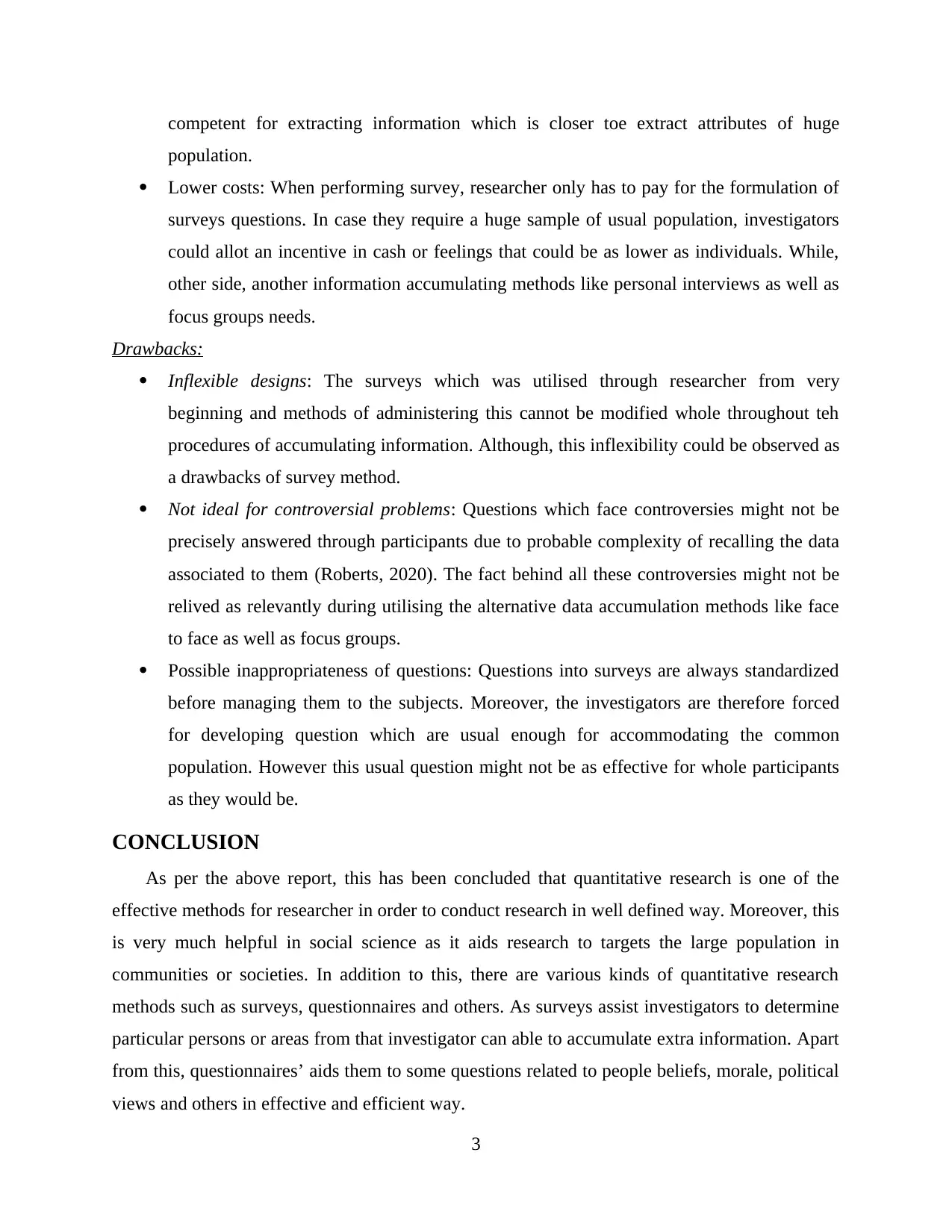
competent for extracting information which is closer toe extract attributes of huge
population.
Lower costs: When performing survey, researcher only has to pay for the formulation of
surveys questions. In case they require a huge sample of usual population, investigators
could allot an incentive in cash or feelings that could be as lower as individuals. While,
other side, another information accumulating methods like personal interviews as well as
focus groups needs.
Drawbacks:
Inflexible designs: The surveys which was utilised through researcher from very
beginning and methods of administering this cannot be modified whole throughout teh
procedures of accumulating information. Although, this inflexibility could be observed as
a drawbacks of survey method.
Not ideal for controversial problems: Questions which face controversies might not be
precisely answered through participants due to probable complexity of recalling the data
associated to them (Roberts, 2020). The fact behind all these controversies might not be
relived as relevantly during utilising the alternative data accumulation methods like face
to face as well as focus groups.
Possible inappropriateness of questions: Questions into surveys are always standardized
before managing them to the subjects. Moreover, the investigators are therefore forced
for developing question which are usual enough for accommodating the common
population. However this usual question might not be as effective for whole participants
as they would be.
CONCLUSION
As per the above report, this has been concluded that quantitative research is one of the
effective methods for researcher in order to conduct research in well defined way. Moreover, this
is very much helpful in social science as it aids research to targets the large population in
communities or societies. In addition to this, there are various kinds of quantitative research
methods such as surveys, questionnaires and others. As surveys assist investigators to determine
particular persons or areas from that investigator can able to accumulate extra information. Apart
from this, questionnaires’ aids them to some questions related to people beliefs, morale, political
views and others in effective and efficient way.
3
population.
Lower costs: When performing survey, researcher only has to pay for the formulation of
surveys questions. In case they require a huge sample of usual population, investigators
could allot an incentive in cash or feelings that could be as lower as individuals. While,
other side, another information accumulating methods like personal interviews as well as
focus groups needs.
Drawbacks:
Inflexible designs: The surveys which was utilised through researcher from very
beginning and methods of administering this cannot be modified whole throughout teh
procedures of accumulating information. Although, this inflexibility could be observed as
a drawbacks of survey method.
Not ideal for controversial problems: Questions which face controversies might not be
precisely answered through participants due to probable complexity of recalling the data
associated to them (Roberts, 2020). The fact behind all these controversies might not be
relived as relevantly during utilising the alternative data accumulation methods like face
to face as well as focus groups.
Possible inappropriateness of questions: Questions into surveys are always standardized
before managing them to the subjects. Moreover, the investigators are therefore forced
for developing question which are usual enough for accommodating the common
population. However this usual question might not be as effective for whole participants
as they would be.
CONCLUSION
As per the above report, this has been concluded that quantitative research is one of the
effective methods for researcher in order to conduct research in well defined way. Moreover, this
is very much helpful in social science as it aids research to targets the large population in
communities or societies. In addition to this, there are various kinds of quantitative research
methods such as surveys, questionnaires and others. As surveys assist investigators to determine
particular persons or areas from that investigator can able to accumulate extra information. Apart
from this, questionnaires’ aids them to some questions related to people beliefs, morale, political
views and others in effective and efficient way.
3
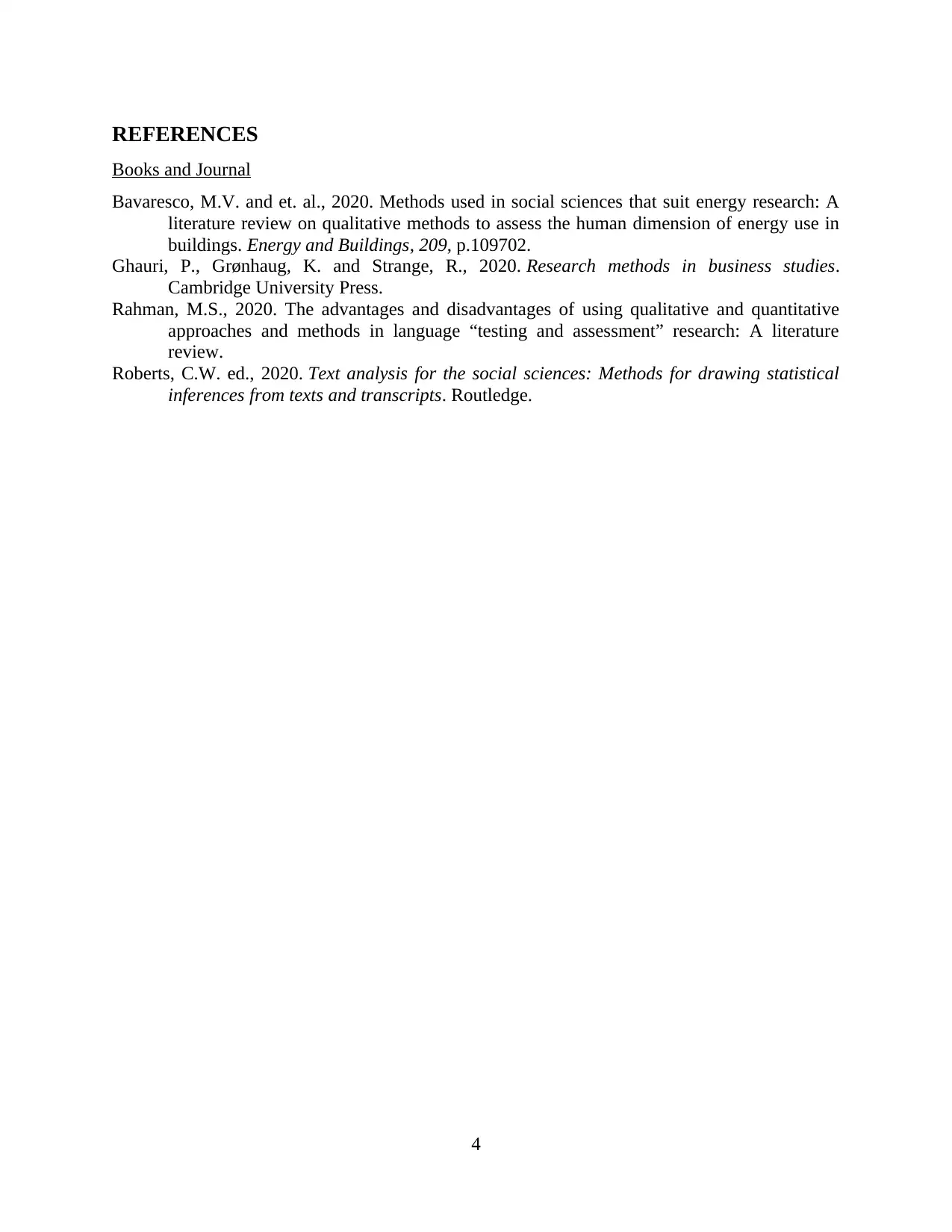
REFERENCES
Books and Journal
Bavaresco, M.V. and et. al., 2020. Methods used in social sciences that suit energy research: A
literature review on qualitative methods to assess the human dimension of energy use in
buildings. Energy and Buildings, 209, p.109702.
Ghauri, P., Grønhaug, K. and Strange, R., 2020. Research methods in business studies.
Cambridge University Press.
Rahman, M.S., 2020. The advantages and disadvantages of using qualitative and quantitative
approaches and methods in language “testing and assessment” research: A literature
review.
Roberts, C.W. ed., 2020. Text analysis for the social sciences: Methods for drawing statistical
inferences from texts and transcripts. Routledge.
4
Books and Journal
Bavaresco, M.V. and et. al., 2020. Methods used in social sciences that suit energy research: A
literature review on qualitative methods to assess the human dimension of energy use in
buildings. Energy and Buildings, 209, p.109702.
Ghauri, P., Grønhaug, K. and Strange, R., 2020. Research methods in business studies.
Cambridge University Press.
Rahman, M.S., 2020. The advantages and disadvantages of using qualitative and quantitative
approaches and methods in language “testing and assessment” research: A literature
review.
Roberts, C.W. ed., 2020. Text analysis for the social sciences: Methods for drawing statistical
inferences from texts and transcripts. Routledge.
4
⊘ This is a preview!⊘
Do you want full access?
Subscribe today to unlock all pages.

Trusted by 1+ million students worldwide
1 out of 6
Related Documents
Your All-in-One AI-Powered Toolkit for Academic Success.
+13062052269
info@desklib.com
Available 24*7 on WhatsApp / Email
![[object Object]](/_next/static/media/star-bottom.7253800d.svg)
Unlock your academic potential
Copyright © 2020–2025 A2Z Services. All Rights Reserved. Developed and managed by ZUCOL.




